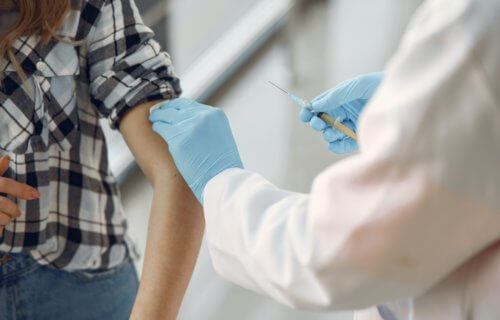BOSTON, Mass. — The coronavirus vaccine has been a polarizing topic almost since the day the public started lining up for shots. In the United States, that debate has already spanned across two presidencies, with opinions for and against vaccinations seemingly shifting with the daily talking points. Now, a new survey finds the American divide on the COVID-19 vaccine is growing even deeper. Although more people now say they’re likely to get the shot, more adults are also playing the “waiting game” during the pandemic.
In a national poll of 75,000 adults conducted this spring, researchers with Tufts University School of Medicine have discovered an 18-percent increase in the number of adults who have received the COVID vaccine or plan to do so. At the same time however, there’s been a five-percent rise in the number of Americans saying they won’t take the shot.
Additionally, among those still planning to get the vaccine, many are not rushing to their local clinics. In fact, 55 percent of these respondents say they’ll “wait and see” before going for the injection. Another 51 percent say they’re still concerned about potential side-effects from taking the coronavirus vaccine and 36 percent think other people need it more than they do.
Although only 10 percent of the poll are firmly in the no-vaccine camp, their reasons are all basically the same. Researchers find 40 percent of those reluctant to get the vaccine say they don’t trust the government, while another 45 percent don’t trust the effectiveness of the shot itself.
Who is still avoiding vaccination?
Among the growing camp of Americans either avoiding or delaying their COVID vaccinations, the poll finds younger adults, African-Americans, those from lower socioeconomic backgrounds, and people living in the southeast are the least likely to get the shot.
“Highlighting vaccines as important for resuming work, school, and social activities is critical to preventing the spread of COVID-19 incidence and bringing an end to the pandemic,” says lead author Dr. Kimberly Nguyen in a media release.
“Also, communicating to the public about the need for vaccination despite a history of covid infection is also important since it remains uncertain if infection provides immunity and if so, how long this protection will last.”
Inching closer to herd immunity?
As of August 2021, more than 70 percent of U.S. adults (or around 181 million people) have received at least one dose of the coronavirus vaccine. However, the national vaccination rate has slowed down in recent months, despite growing availability.
Between September and December 2020, amid a divisive election, previous studies found that only 50 percent of U.S. adults planned to get the COVID-19 vaccine. The new survey, conducted between January and March 2021, shows that number jumped from 54 percent to more than 72 percent.
While the increase comes as good news to doctors, those numbers still diverge among certain groups of the population. The team finds older adults are more likely to get the vaccine than those between 18 and 49 years-old. Asians and Hispanics are also more likely to get vaccinated in comparison to Whites.
“In addition to age and racial/ethnic differences in COVID-19 vaccine intentions, disparities continue to exist among vulnerable populations, such as among individuals with lower levels of education and income. Providing clear messages on vaccine safety and effectiveness is important for increasing vaccination uptake and confidence among these groups,” Nguyen adds.
COVID vaccine hesitancy down south
The poll also discovered vaccine hesitancy is much stronger in the southern and southeastern U.S. — specifically in Alabama, Florida, Georgia, Kentucky, Mississippi, North Carolina, South Carolina, and Tennessee.
“Lower vaccination and intent among these southeastern states may be driven by access issues, such as vaccine supply, vaccination clinic availability, lack of prioritization of vulnerable groups, or vaccine hesitancy,” Nguyen concludes.
“Potential ways to increase COVID-19 vaccine coverage and intent include increasing confidence in vaccines among vulnerable groups, monitoring and addressing barriers to vaccination, directing vaccines to vulnerable communities, offering free transportation to vaccination sites or opening sites at more accessible locations, and engaging communities to build trust and collaboration. More efforts are needed to understand these differences among states to identify best practices for improving vaccine uptake.”
The study appears in the journal Annals of Medicine.
